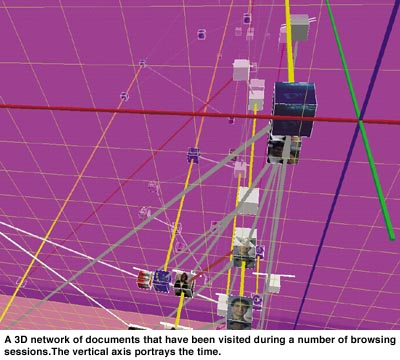

by Emmanuel Frécon
WebPath is a virtual reality based application that provides an easily recognisable presentation of your browsing history. The different dimensions of a 3-D space are used to position representations of documents using different metrics, together with their relationships.
Only a few years ago, Web browsing was seen as an interesting possibility. It is now part of our working and leisure activities, and the time we spend looking for information ‘out there’ increases. As it becomes easier to publish documents, as the number of users, and thus publishers, increases and as the number of documents grows, searching for information is turning into a cumbersome and time-consuming operation. Moreover, because of the loose inter-connection among documents, people have difficulty returning to previously visited pages and remembering where they have been.
SICS and Lancaster University have prototyped WebPath, a virtual reality (VR) based application to be used alongside traditional Web browsers. A driving motivation for this work is specifically to assist users in scenarios where they are searching for pages previously visited. These scenarios include requests such as: “I want to find a page I visited this morning, all I know is that it had no images in it”; “I remember the page was from Asia somewhere”; “It had many links and the latest news in it”; and “It took a very long time to load”.
WebPath provides a 3D structure to the network of documents that have been visited during a number of browsing sessions. A three-dimensional presentation was chosen for maximum flexibility in data visualisation. The different dimensions of a 3-D space are used to position representations of documents using different metrics, together with their relationships. The result is an easily recognisable presentation of your browsing history.
The presentation can be tailored in terms of its overall structure and the appearance of individual pages. When a user loads a new document (using any of the methods offered by existing browsers: bookmarks, history facilities, manual location entry, etc.), WebPath will create a representation for that document and the user will be smoothly transported in front of it. Each Web document is represented as a cube that is labelled with the document’s title and appears as any one of: the page’s background image, an image in-lined in the HTML document or simply the background colour of that page. In order to indicate the structure of the user’s browse path, WebPath connects the cubes with arrows. The colour of the arrow indicates the nature of the link, for example, does the destination document originate from the same site as the previous document?

WebPath uses three orthogonal dimensions to visualise the browsing history. A number of metrics are available, such as page size or number of images contained in a document. Any of these metrics can be applied to the two horizontal axes (x and z). The vertical axis (y) is always reserved to portray the time at which the documents were visited, the last visited document is always the top-most one. If a document happens to be revisited, it will generate a new cube, but all representations for the same document are vertically linked to ease recognition
Clicking on a cube within the visualisation will cause the user’s browser to re-load the associated Web page. When the user selects a new document location using the different direct methods (ie bookmarks, history facilities or manual entry), he/she starts a new browsing session and a semitransparent horizontal plane, covering the whole visualisation area is generated just below the new representation. When many planes have been created (ie when a user has been engaged in several Web sessions) older documents, towards the bottom of the visualisation space, will appear through an increasingly dense fog, thus, reducing the user’s awareness of their previous results. When looking back for previous documents, all the cubes resulting from a browsing sub-session are “isolated” in-between two semitransparent layers, which visually separates them from the rest of the data.
WebPath is a tool that unobtrusively visualises the users trail of URLs as they browse the Web, which can be tailored to best suit the users working needs. WebPath provides users with a graphical view of their recent activities, enabling them to for example, see how a given document was reached and visually perform complex searches for previous documents visited. WebPath has raised substantial interest, ranging from casual users to scientific researchers. The authors are currently looking into commercial ways to distribute an improved version of the software.
Links:
http://www.comp.lancs.ac.uk/computing/users/gbs/webpath
Please contact:
Emmanuel Frécon - SICS
Tel: +46 8 633 15 34
E-mail: emmanuel@sics.se